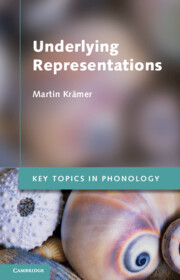Book contents
- Frontmatter
- Contents
- Acknowledgements
- Abbreviations
- 1 Getting started
- 2 Arbitrariness and opposition
- 3 Derivation and abstractness
- 4 Underspecification returns
- 5 The devil is in the detail
- 6 Psycho- and neurolinguistic evidence
- 7 On the form and contents of contrastive features
- 8 Underlying representations in Optimality Theory
- 9 Preliminary results
- Glossary
- Notes
- References
- Name index
- Language index
- Subject index
1 - Getting started
Published online by Cambridge University Press: 05 November 2012
- Frontmatter
- Contents
- Acknowledgements
- Abbreviations
- 1 Getting started
- 2 Arbitrariness and opposition
- 3 Derivation and abstractness
- 4 Underspecification returns
- 5 The devil is in the detail
- 6 Psycho- and neurolinguistic evidence
- 7 On the form and contents of contrastive features
- 8 Underlying representations in Optimality Theory
- 9 Preliminary results
- Glossary
- Notes
- References
- Name index
- Language index
- Subject index
Summary
It is the holy grail of phonology to be sure of what the underlying form is.
(William Labov, 21 May 2010, Manchester Phonology Meeting)WHAT THIS BOOK IS ABOUT
This book surveys the development of the concept of underlying representation or underlying form over the last 100 years or so within the field of generative phonology and its predecessors. We will consider phonological patterns and phenomena such as hypercorrection, linguistic experiments, statistical generalizations made over data corpora as well as theoretical arguments that have been used as arguments for underlying representations, their form and degree of (under)specification or the absence of such abstract entities. We will necessarily also look at the theoretical background that shaped our understanding of underlying representations at different times. Finally, a view of underlying representations will be converged on that sees two principles of economy as central in the determination of underlying representations: the avoidance of unnecessary information and the (over)generalization of alternation-inducing patterns to non-alternating forms as a strategy to achieve this goal of lexical parsimony. These principles, designed to maximize different aspects of lexical economy, actually stand in conflict with each other. It will be shown that these conflicts lead in some instances to underlying representations that defy common intuitions on economic lexical representations.
One cannot think about underlying representations without considering what their basic building blocks are. Accordingly, this book will also discuss this aspect of underlying representations. Originally, the smallest unit of phonology was thought to be the phoneme. As in physics, it turned out very soon that the atomic unit consisted of smaller elements or particles, the contrastive features. The nature of these features and their contents are pragmatically defined as relating them to their articulation or to the corresponding acoustic signal, though we will see that there is considerable dissent when it comes to the details. On the basis of economy considerations, we will end up with a theory of features that connects the smallest building blocks of phonological representations with concepts from other domains of cognition, but especially with other modules of the language faculty.
- Type
- Chapter
- Information
- Underlying Representations , pp. 1 - 11Publisher: Cambridge University PressPrint publication year: 2012



